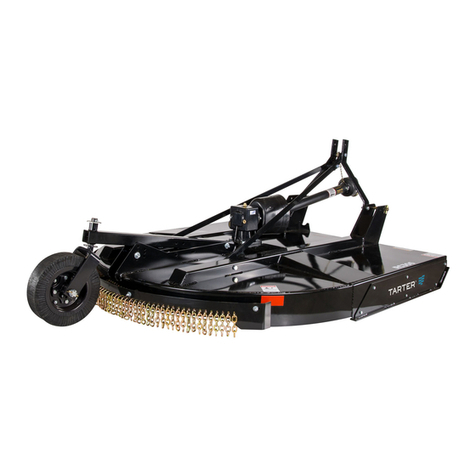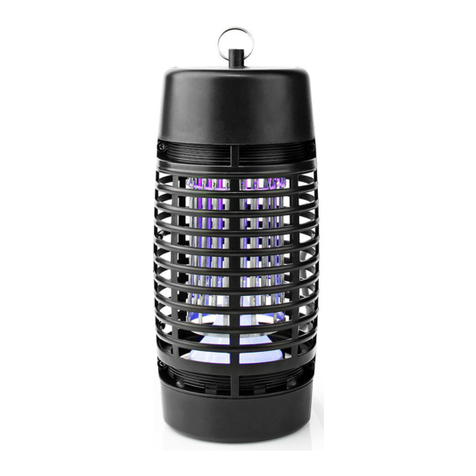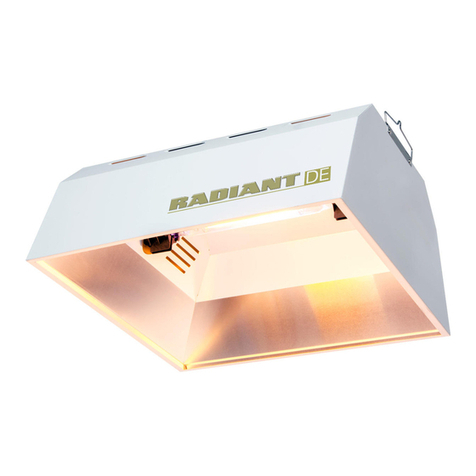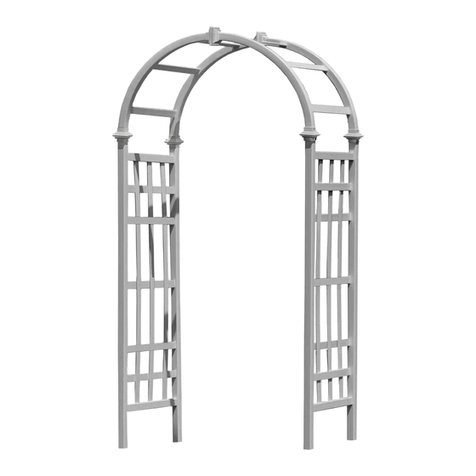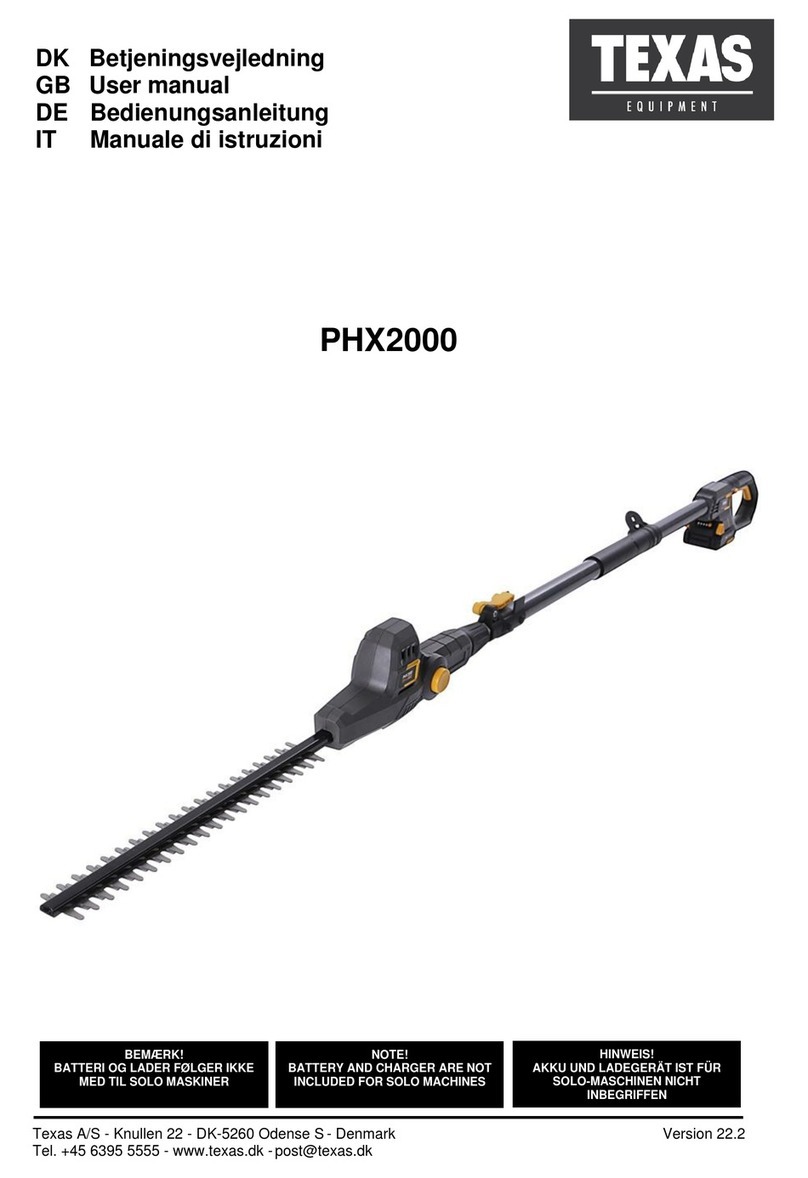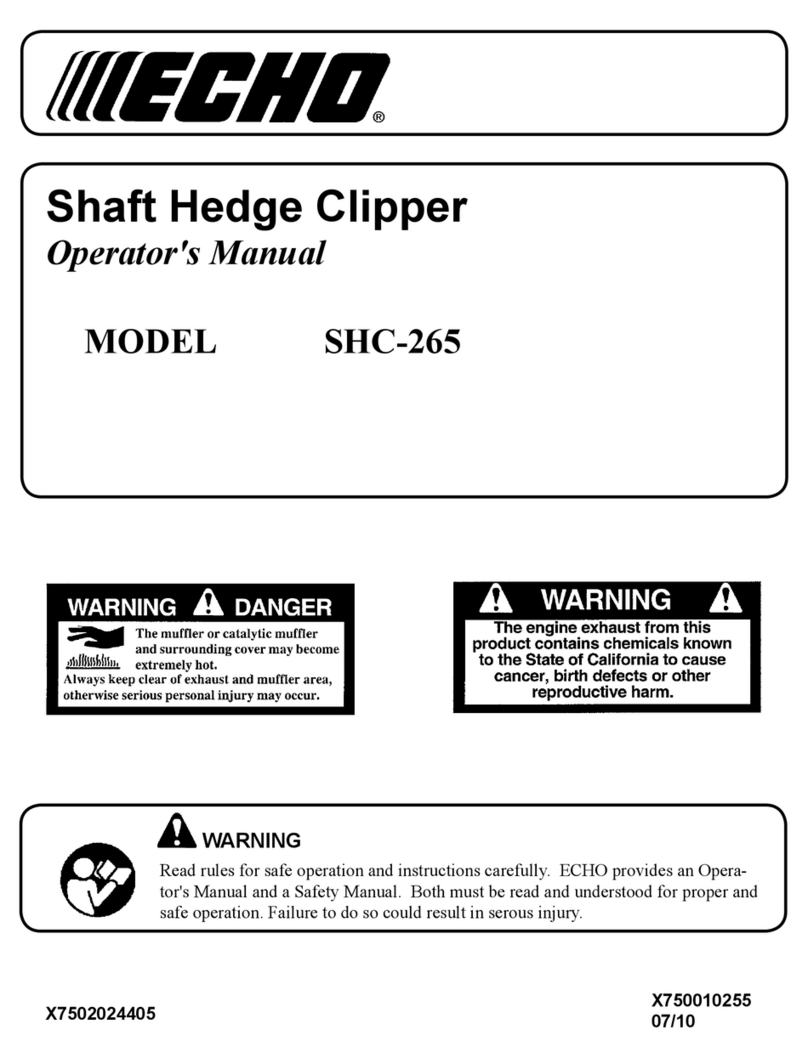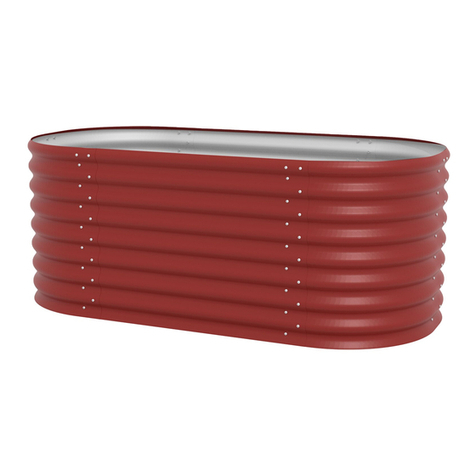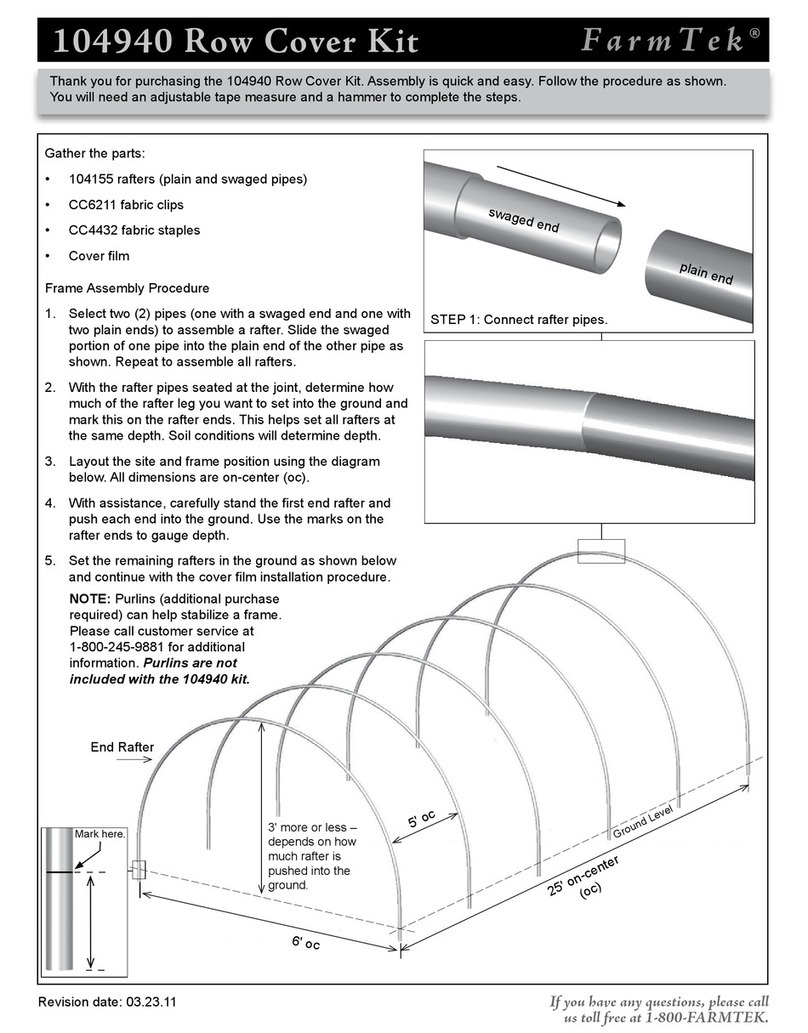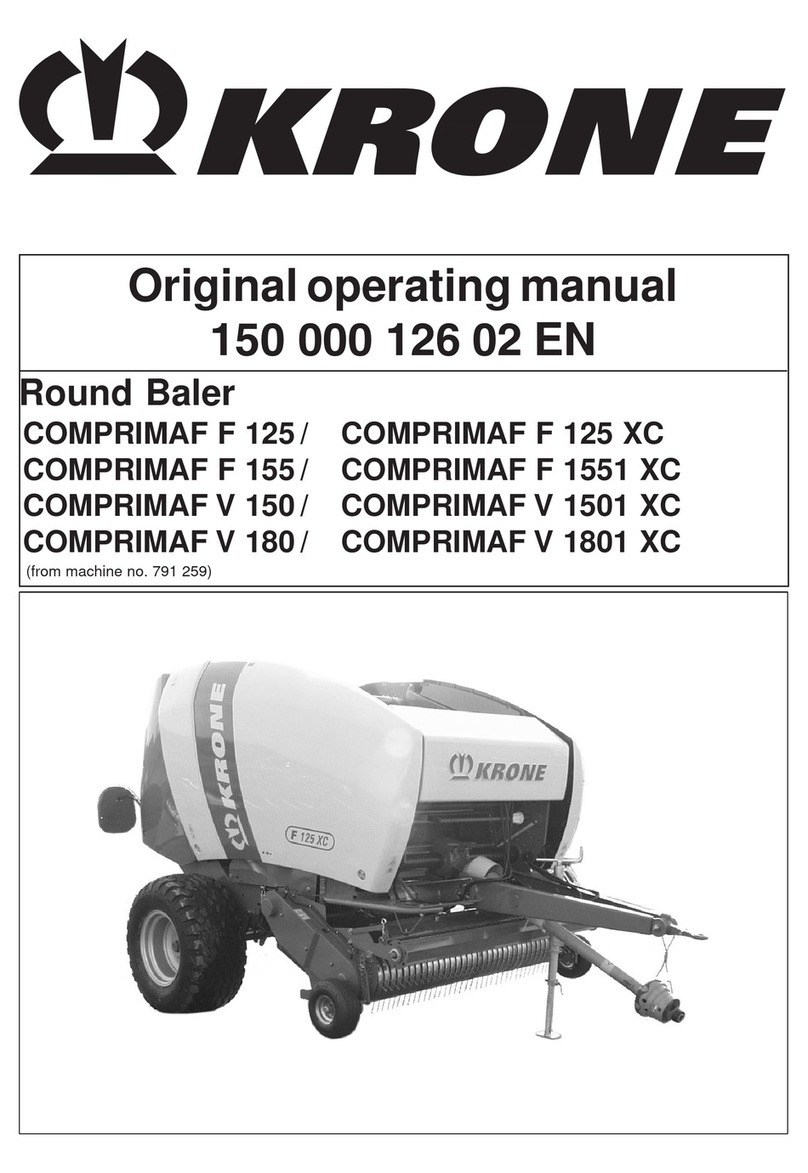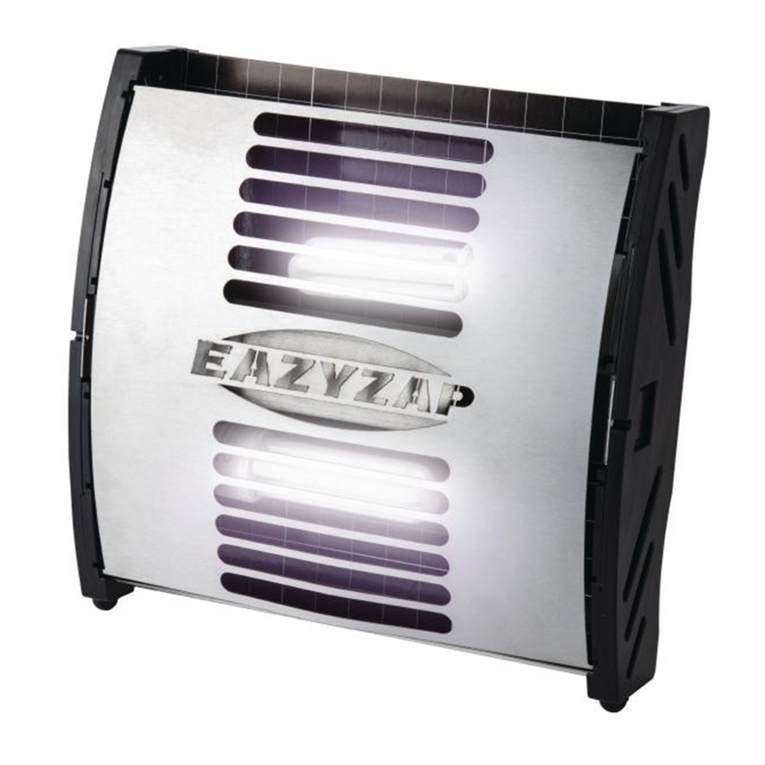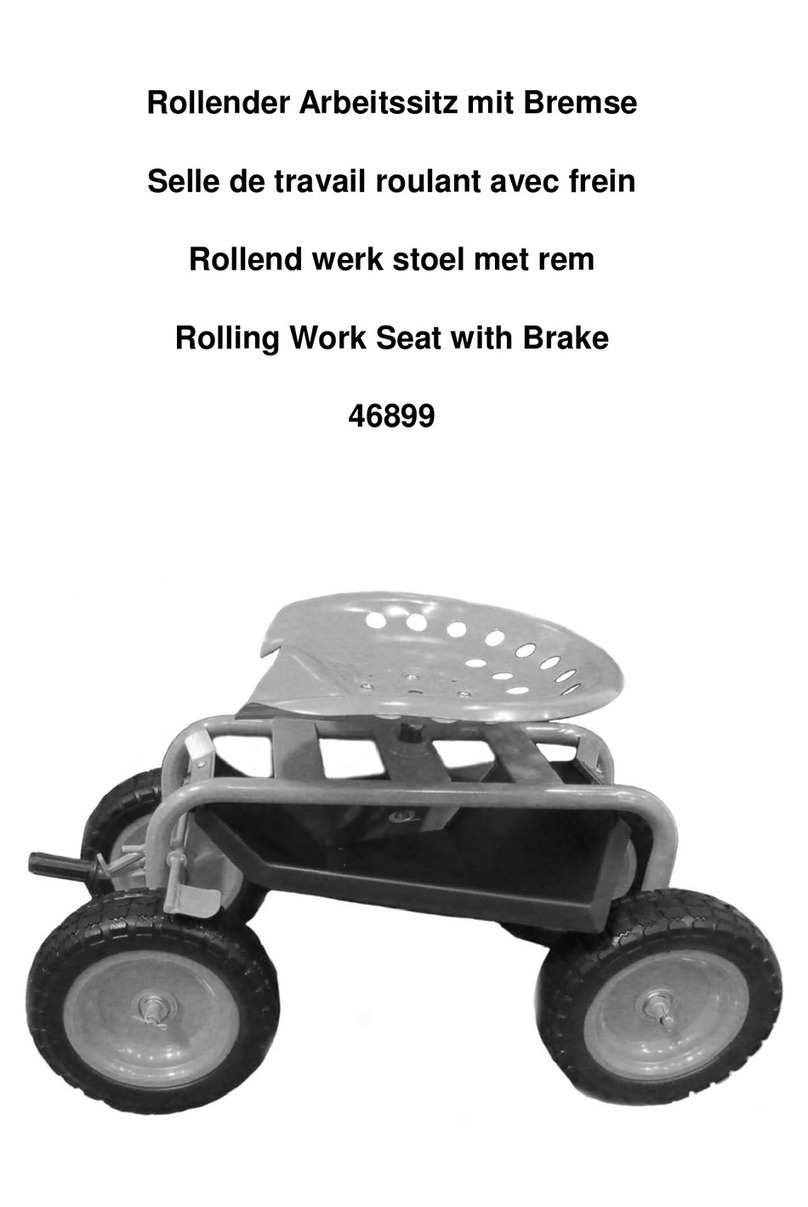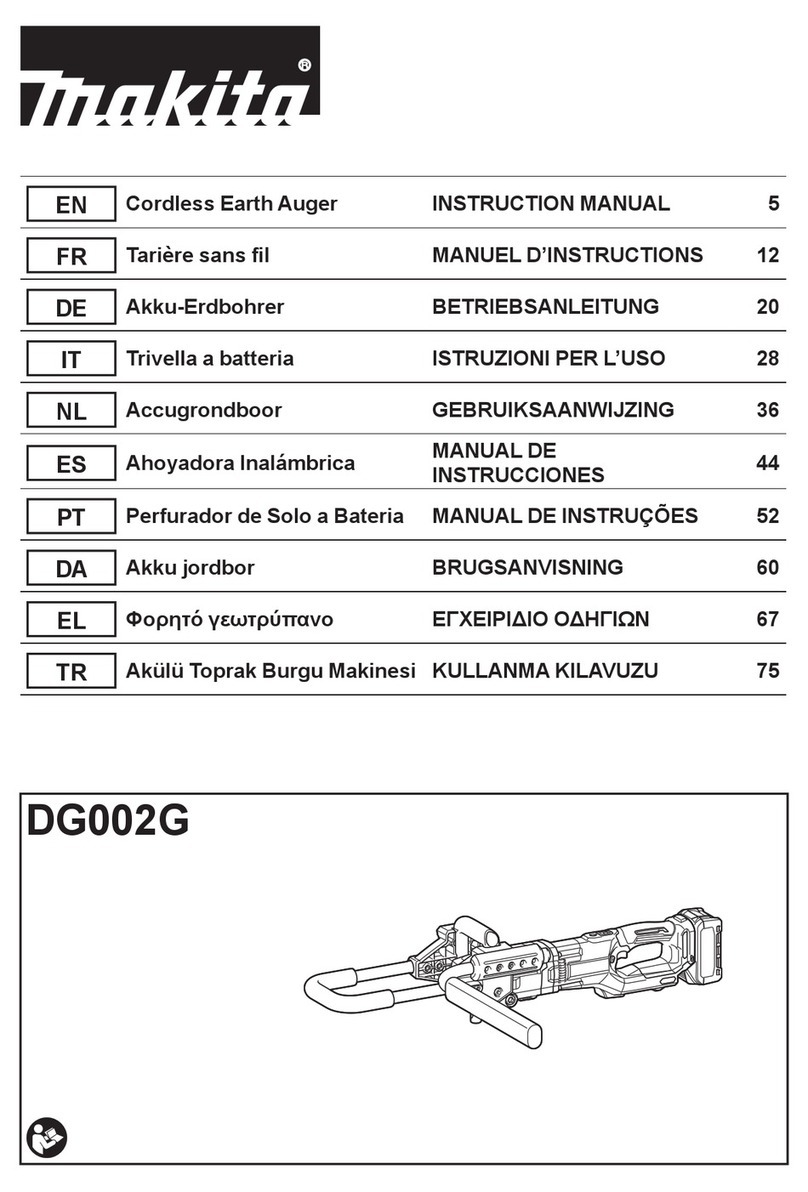Tarter RT205BL User manual

TARTERUSA.COM
For more information and questions, please contact:
Tarter Customer Service
1800REDGATE 18007334283
Tarter products are sold through Authorized Retailers.
OPERATION AND ASSEMBLY MANUAL
RT205BL,RT206BL,RT207BL
ROTARY TILLER

2
INTRODUCTION
TO THE OWNER:
Read this manual before operating your Tarter product. Keep this manual handy for reference.
Require all operators to read this manual carefully and become acquainted with all adjustments and
operating procedures before attempting to operate the equipment.
The equipment you have purchased has been carefully engineered and manufactured to provide
dependable and satisfactory use. Like all mechanical products, it will require cleaning and upkeep.
Lubricate the unit as specified. Please observe all safety information in this manual and safety decals
on the equipment. Use only genuine Tarter service parts. Substitute parts will void the warranty and
may not meet standards required for safe and satisfactory operation.
THANK YOU FOR PURCHASING THIS PRODUCT
Thank you for choosing Tarter – congratulations on your purchase. Tarter Farm and Ranch
Equipment has been improving life on your land since 1945. You have purchased one of our
dependable 3-point implements. Through proper care and operation you can expect to receive many
years of service when maintained and used in accordance within the capabilities of this implement.
TARTERUSA.COM
For more information and questions, please contact:
Tarter Customer Service
1800REDGATE 18007334283
CUSTOMER INFORMATION
Name___________________________________________________
Purchased From__________________________________________
Date Purchased___________________________________________
Model__________________________________________________
Serial #_________________________________________________
PREPARATION CHECKLIST
Verify the following before operating your Rotary Tiller
1. Implement is completely assembled.
2. Gearbox is filled with oil and checked for
possible leaks.
3. All fittings are lubricated.
4. All shields in place and in good condition.
5. All fasteners torqued to specifications in
torque chart. (Pg. 27)
6. Check PTO driveline. Make sure it is the correct
length to operate rotary tiller with intended
tractor.
7. All decals in place and legible.
8. Overall condition good (i.e. paint, welds)
9. Operator’s manual has been given to owner and
the owner has been instructed on the safe and
proper use of the Rotary Tiller.

3
TABLE OF CONTENTS
Safety ..................................................................................................................................................................................4
Description ........................................................................................................................................................................9
Safety Description and Decals ....................................................................................................................................10
Assembly ..........................................................................................................................................................................12
Modify PTO Driveline......................................................................................................................................................16
Operation/Maintenance................................................................................................................................................19
ReversingTillerTineDirection.....................................................................................................................................20
Attaching/Storage.........................................................................................................................................................22
Product Specifications..................................................................................................................................................23
Parts..................................................................................................................................................................................24
Torque Specifications...................................................................................................................................................29
Trouble Shooting............................................................................................................................................................30
Warranty............................................................................................................................................................................31
Notes.................................................................................................................................................................................33
TABLE OF CONTENTS

4
Safety is a primary concern in the design and manufacturing of our products. Unfortunately, our efforts to
provide safe equipment can be eliminated by an operator’s single careless act.
In addition to the design and configuration of equipment, hazard control and accident prevention are dependent
upon the awareness, concern, judgment, and proper training of personnel involved in the operation, transport,
maintenance and storage of equipment.
It has been said “The best safety device is an informed, careful operator.” We ask you to be that kind of operator.
SAFETY
Throughout this manual, the term IMPORTANT is used to indicate that failure to observe procedures
can cause damage to equipment. The terms CAUTION, WARNING and DANGER are used in
conjunction with the Safety-Alert Symbol, (a triangle with an exclamation mark), to indicate the degree
of hazard for items of personal safety.
This Safety-Alert Symbol indicates a hazard and means ATTENTION!
BECOME ALERT! YOUR SAFETY IS INVOLVED!
Indicates an imminently hazardous situation that, if not avoided, will
result in death or serious injury.
Indicates a potentially hazardous situation that, if not avoided, could
result in death or serious injury, and includes hazards that are exposed when
guards are removed.
Indicates a potentially hazardous situation that, if not avoided, may
result in minor or moderate injury.
Indicates that failure to observe can cause damage to equipment.
Indicates helpful information.
WARNING
CAUTION
IMPORTANT
NOTE

5
SAFETY
(Safety continued on next page)
TRAINING
Safety instructions are important! Read all attachments
and power unit manuals; follow all safety rules and
safety decal information. (Replacement manuals and
safety decals are available from Tarter Farm and Ranch
Equipment) Failure to follow instructions or safety rules
can result in serious injury or death.
If you do not understand any part of this manual and
need assistance, please contact Tarter Farm and Ranch
Equipment.
Know your controls and how to stop the engine and
implement quickly in an emergency. Operators must
be instructed in and be capable of the safe operation of
the equipment, its attachments, and all controls. Do not
allow anyone to operate this equipment without proper
instructions.
Never allow children or untrained persons to operate
equipment.
PREPARATION
Check that all hardware is properly installed.
Always tighten to torque chart specifications unless
instructed otherwise in this manual.
Always wear relatively tight and belted clothing to avoid
getting caught in moving parts. Wear sturdy, rough-
soled work shoes and protective equipment for eyes,
hair, hands, ears, and head; wear respirator or filter mask
where appropriate.
Make sure implement is properly secured, adjusted, and
in good operating condition.
Make sure collar slides freely and is seated firmly in
tractor PTO spline groove.
Before servicing equipment, check and adjust driveline
length as instructed in Operator’s Manual. Driveline must
not bottom out or pull apart throughout the full range of
the tractor hitch. Do not operate until driveline length
is correct. Make sure driveline shield safety chain is
attached as shown in this manual. Replace if damaged
or broken. Check that driveline guards rotate freely on
driveline before servicing equipment.
Before starting power unit, check all equipment driveline
guards for damage. Replace any damaged guards.
Make sure all guards rotate freely on all drivelines. If
guards do not rotate freely on drivelines, repair and
replace bearings before servicing equipment.
Inspect chain or rubber guards before each use. Replace
if damaged.
Remove accumulated debris from this equipment, power
unit, and engine to avoid fire hazard.
Power unit must be equipped with ROPS or ROPS cab
and seat belt. Keep seat belt securely fastened. Falling
off power unit can result in death from being run over
or crushed. Keep foldable ROPS system in “locked up”
position at all times.
A minimum of 20% of tractor and equipment weight
must be on the tractor’s front wheels when implements
are in transport position. Without this weight, tractor
could tip over, causing personal injury or death. The
weight may be attained with a loader, front wheel
weights, ballast in tires or front tractor weights. Weigh
the tractor and equipment. Do not estimate.
Make sure all safety decals are installed. Replace if
damaged. (See Safety Decals section for location.)
Make sure shields and guards are properly
installed and in good condition. Replace if damaged.
Inspect and clear area of stones, branches, or other hard
objects that might be thrown, causing injury or damage.
STARTING AND STOPPING
Check the tractor master shield over the PTO (power
take off) stub shaft. Make sure it is in good condition and
fastened securely to the tractor. Purchase a new shield if
old shield is damaged or missing.
All tractors that are not equipped with a “live” power
takeoff (PTO) must be equipped with an over-running
PTO clutch. These are available through most farm
equipment stores.
NOTE: The addition of an over-running PTO clutch may
change the length of the PTO driveline required. Be
sure to refer to the instructions on the PTO driveline
installation. Be sure that the driveline system guarding is
adequate.

6
SAFETY
(Safety continued from previous page)
Implement operating power is supplied from the tractor
PTO. Refer to the tractor manual for PTO engagement
and disengagement instructions.
Understand how to stop tractor and implement quickly in
case of an emergency.
When engaging the PTO, the engine RPM should always
be at idle speed. Once engaged and ready to start,
raise PTO speed to 540-RPM and maintain throughout
operation.
TRANSPORTATION
Power unit must be equipped with ROPS or ROPS cab
and seat belt. Keep seat belt securely fastened. Falling
off power unit can result in death from being run over
or crushed. Keep foldable ROPS system in “locked up”
position at all times.
A minimum of 20% of tractor and equipment weight
must be on the tractor’s front wheels when implements
are in transport position. Without this weight, tractor
could tip over, causing personal injury or death. The
weight may be attained with a loader, front wheel
weights, ballast in tires or front tractor weights. Weigh
the tractor and equipment. Do not estimate.Always
comply with all state and local lighting and marking
requirements.
Never allow riders on power unit or implement.
Do not operate PTO during transport.
Watch for hidden hazards on the terrain.
Do not operate or transport on steep slopes.
Do not operate or transport equipment while under the
influence of alcohol or drugs.
When encountering rough terrain during transport,
reduce tractor speed to minimize the horizontal
movement of implement.
Stabilizer bars should be used during transport to
reduce lateral movement of implement
OPERATION
Do not allow bystanders in the area when operating,
attaching, removing, assembling, or servicing
equipment.
Never discharge directly toward people, animals, or
property.
Ensure the rear guard assembly is in place to reduce the
possibility of objects being thrown.
This implement is intended for agricultural applications
only. Do not operate within 300 feet of bystanders or
public roads or highways.
Do not operate or transport equipment while under the
influence of alcohol or drugs.
Keep hands, feet, hair, and clothing away from
equipment while engine is running. Stay clear of all
moving parts.
Operate only in daylight or satisfactory artificial light.
Always comply with all state and local lighting and
marking requirements.
Never allow riders on power unit or implement.
Operate tractor PTO at 540 RPM. Do not exceed
Power unit must be equipped with ROPS or ROPS cab
and seat belt. Keep seat belt securely fastened.
Falling off power unit can result in death from being run
over or crushed. Keep foldable ROPS system in “locked
up” position at all times.
Always sit in power unit seat when operating controls
or starting engine. Securely fasten seat belt, place
transmission in neutral, engage brake, and ensure all
other controls are disengaged before starting power unit
engine.
Do not operate PTO during transport.
Look down and to the rear and make sure area is clear
before operating in reverse (reverse operation is not
recommended).
Do not operate or transport on steep slopes.
Do not stop, start, or change directions suddenly on
slopes.
Use extreme care and reduce ground speed onslopes
and rough terrain.
Watch for hidden hazards on the terrain during
operation.
Stop power unit and equipment immediately upon
striking an obstruction. Turn off engine, remove key,
inspect, and repair any damage beforeresuming
operation.
Leak down or failure of mechanical or hydraulic system
can cause equipment to lower.
MAINTENANCE

7
SAFETY
(Safety continued on next page)
Before detaching power unit or performing any
service or maintenance, follow these steps: disengage
power to equipment, lower the 3-point hitch and all
raised components to the ground, set parking brake,
stop engine, remove key, and unfasten seat belt.
Before performing any service or maintenance,
disconnect driveline from tractor PTO.
Before working underneath, carefully read Operator’s
Manual instructions, disconnect driveline, raise
implement, securely block up all corners with jack
stands, and check stability. Secure blocking prevents
equipment from dropping due to hydraulic leak down,
hydraulic system failures, or mechanical component
failures.
Do not modify, alter, or permit anyone else to modify or
alter the equipment or any of its components in any way.
Always wear relatively tight and belted clothing to avoid
getting caught in moving parts. Wear sturdy, rough-
soled work shoes and protective equipment for eyes,
hair, hands, ears, and head; wear respirator or filter mask
where appropriate.
Make sure implement is properly secured, adjusted, and
in safe operating condition.
Keep all persons away from operator control area while
performing adjustments, service, or maintenance.
Never go underneath equipment (lowered to the ground
or raised) unless it is properly blocked and secured.
Never place any part of the body underneath equipment
or between moveable parts even when the engine has
been turned off. Hydraulic system leak down, hydraulic
system failures, mechanical failures, or movement of
control levers can cause equipment to drop or rotate
unexpectedly and cause severe injury or death. Follow
Operator’s Manual instructions for working underneath
and blocking procedures.
Make certain all movement of equipment components
has stopped before approaching for service.
Frequently check blades/tines/shanks. They should be
sharp, free of nicks and cracks, and securely fastened.
Do not handle blades/tines/shanks with bare hands.
Careless or improper handling may result in serious
injury.
STORAGE
Block equipment securely for storage.
Keep children and bystanders away from storage area.
Follow manual instructions for storage.
Always use a tractor to position equipment for storage.
Never attempt to move equipment by hand.
EQUIPMENT SAFETY GUIDELINES
Safety of the operator and bystanders is one of the
main concerns in design and development. However,
accidents always occur which could have been avoided
by a few seconds of thought and a more careful approach
to handling equipment. You, the operator, can avoid
many accidents by observing the following precautions
and insist those working with you, follow them.
In order to provide a better view, certain photographs or
illustrations in this manual may show an assembly with a
safety shield removed. However, equipment should never
be operated in this condition. Keep all shields in place. If
shield removal becomes necessary for repairs, replace the
shield prior to use.
Replace any safety sign that is illegible or missing.
Location of such safety signs are indicated in this manual.
Never use alcoholic beverages or drugs that can hinder
alertness or coordination while operating this equipment.
Consult your doctor about operating this machine while
taking prescription medications.
Under no circumstances should children under the
age of 18 be allowed to operate this equipment. Do not
allow persons to operate or assemble this unit until they
have read this manual and have developed a thorough
understanding of the safety precautions and how it works.
Review the safety instructions with all users annually.
This equipment can be dangerous to children and
persons unfamiliar with its operation. The operator should
be a responsible, properly trained and physically able
person familiar with farm machinery and trained in this
equipment’s operations.
Use a tractor equipped with a Roll Over Protective System
and seat belts. (ROPS)
Never exceed the limits of a piece of machinery. If its
ability to perform a job safely, is in question, DO NOT TRY
IT.
Do not modify the equipment in any way. Unauthorized
modification could result in serious injury or death and
may impair the function and life of the equipment.
In addition to the design and the confirmation of
this implement, including safety signs and safety
equipment, hazard control and accident prevention
are dependent upon the awareness, concern,

8
(Safety continued from previous page)
SAFETY
prudence, and proper training of personnel involved in
the operation, transport, maintenance, and storage of the
machine. Refer also to safety messages and operation
instruction in each of the appropriate sections of the
tractor and implement manuals. Heed the safety signs
affixed to both the tractor and implement.

9
DESCRIPTION
GENERAL DESCRIPTION
Your Rotary Tiller has been carefully designed for cultivating and stirring up soil for gardens, food
plots and other tillage needs. This manual is provided to give you the necessary operation and
maintenance instructions for keeping your rotary tiller in excellent operating condition. Please read
this manual thoroughly. Understand the purpose of the controls and how to use them. Observe
all safety precautions on the machine and as noted throughout this manual. If any assistance or
additional information is needed, contact us at 1-800-RED-GATE.
Major Components
NOTICE
All information, illustrations, and specifications in this manual are based on the latest information available
at the time of publication. Because we are always striving to improve our products, the images could differ
slightly from actual equipment. Specifications are subject to change without notice. We also reserve the right
to make changes at any time without notice.
Deck
A-Frame
Top
Gearbox
PTO
Shaft
Tine Bar
Assembly
Side
Gearbox
Rear Guard
Assembly
Skid
Shoes
Parking
Stand

10
SAFETY and INSTRUCTIONAL DECALS
ATTENTION! BECOME ALERT! YOUR SAFETY IS INVOLVED!
Replace Immediately if Damaged!
SAFETY AND INSTRUCTION DECALS
13
7
6
8
5
2
4
4
9
10

11
SAFETY and INSTRUCTIONAL DECALS
ATTENTION! BECOME ALERT! YOUR SAFETY IS INVOLVED!
Replace Immediately if Damaged!
SAFETY AND INSTRUCTION DECALS

12
ASSEMBLY
TOOLS REQUIRED
* TIN SNIPS
* SOCKETS AND WRENCHES - 9/16”, 3/4”, 15/16”,
AND 1-1/4”. (IMPACT WRENCH IS PREFERRED)
1. With Rotary Tiller still in the rack, set it on a level
spot for assembly.
2. Remove the PTO Shaft, leaving the chains attached
to the PTO.
3. Remove A-Arms and Back Straps using a 3/4”
wrench. Set aside after removing.
*NUTS AND BOLTS CAN BE DISCARDED
*Remove
hardware box
and set aside.
(Hardware box
contents are
listed on
pg. 29)
4. Remove the PTO shield.
5. Insert lift strap and slowly lift Rotary Tiller.
*BE CAUTIOUS OF WEIGHT SHIFTING WHEN
LIFTING.
6. With pressure relieved from the bolts, remove the
bolts, from the tiller rack, using 3/4” wrenches.
*Discard bolts.

13
ASSEMBLY
7. Before setting on level ground, remove the pin
from the kick stand, flip the kick stand over and set at
desired height.
8. Adjust Skid Shoes as needed.
9. Set the Rotary Tiller on level ground.
10. Install the A-Arms onto
the Rotary Tiller, using the
CAT I pins and the
5/8” x 2” bolts on the
inside of the deck bracing.
*CAT I pins are installed in the front hole and the
(2) 5/8” x 2” grade 5 bolts are installed in the rear.
11. Attach the rounded end of the back brace to the
outside of the rear tiller deck bracing using (2) 5/8” x
2” Grade 5 hex bolt.
12. Repeat for opposite side.
13. Attach the square end of the back brace to the
inside A-Arm plates using 1-1/2” spacer and 5/8” x 4”
hex bolt.

14
ASSEMBLY
14. Assemble 5/8” x 4” hex bolt and 2-1/4” spacer.
15. Attach the PTO Shield to the A-Arm plates
using 1/4” x 3/4” hex bolt.
16. Fully tighten all bolts.
17. Install the PTO guard using four (4) 1/2” x 3/4”
bolts and washers. Make sure the opening on the
PTO guard is on the top.
18. Install PTO driveline.
19. Remove bolt from the PTO shaft. Slide the PTO
shaft onto the gearbox and reinstall the bolt through
the opening in the PTO shaft guard.
20. Assembly of your Rotary Tiller is now complete.
Please read the next section of this manual for filling
gearboxes with oil and lubricating instructions.

15
ASSEMBLY
BEFORE PUTTING YOUR ROTARY TILLER INTO
SERVICE
IMPORTANT: This tiller was shipped without oil in
the gearboxes and without grease in the the grease
fittings. UNIT MUST BE SERVICED BEFORE USE.
NOTE: Fill the gearboxes using EP 85-90W gear
oil. For all grease fittings use TYPE/Grade II tube
grease.
1. Please ensure that your Rotary Tiller is secure and
level.
2. Using a wrench, remove the 1/2” vented pipe
plug located on top of the gearbox, above the PTO
shaft.
3. Remove the check plug, located on the back of the
gearbox.
4. Fill the gearbox using specified gear oil, until oil
begins to overflow from the check plug hole in the
rear. (Holds approx. 1-1/2 quarts.)
5. Replace and tighten the check plug.
DO NOT overfill gearbox. This could
cause damage to oil seals and can cause
permanent damage to the gearbox. This
issue will not be covered under warranty.
CAUTION
6. Replace and tighten the 1/2” vented pipe plug and
clean away any excess oil.
7. Using a wrench, remove the 1/2” pipe plug
located at the top of the side gearbox and the 1/8”
check plug located on the side of the side gearbox.
8. Fill the side gearbox using specified gear oil until
the oil begins to overflow from the check plug hole.
(Holds approx. 2-1/2 quarts.)
9. Replace and tighten the 1/2” vented pipe plug and
the 1/8” check plug. Clean away any excess oil.
DO NOT overfill gearbox. This could
cause damage to oil seals and can cause
permanent damage to the gearbox. This
issue will not be covered under warranty.
CAUTION
10. Grease the grease fitting on the out-board hub.
11. Grease the two grease fittings on the PTO
universal joints.
12. Grease the two grease fittings on the PTO
safety shield.
13. Separate the PTO shaft and grease the inner
surface.

16
Final Inspection and Adjustments
IMPORTANT: PTO driveline may be too long for some tractor models, causing tractor transaxle damage.
Modify driveline if necessary.
Attach rotary tiller to tractor and check tiller-to-tractor driveline telescoping length clearance.
(See MAINTENANCE BEFORE EACH USE in Lubrication and Maintenance section.)
• Modify PTO Driveline (If Necessary)
1. To adjust the length, hold the half-shafts next
to each other in the shortest working position
and mark them.
2. Shorten inner and outer guard tubes equally.
3. Shorten inner and outer sliding profiles by the
same length as the guard tubes.
4. Round off all sharp edges and remove burrs.
Grease sliding profiles. No other changes
may be made to PTO drive shaft and guard.
5. Chains must be fitted so as to allow sufficient
articulation of the shaft in all working positions.
6. The PTO drive shaft must not be suspended
from the chains!
MODIFY PTO DRIVELINE
MODIFYING PTO

17
INNER SHAFT
INNER DRIVELINE
OUTER DRIVELINE
INNER SHIELD
OUTER SHAFT
OUTER SHIELD
UNIVERSAL
JOINT SHIELD
TRACTOR END
IMPLEMENT END
Figure 1 - Driveline Shortening
A
B
B
X
Y
X1
Y1
FREE LENGTH IMPLEMENT END
INNER PROFILEOUTER PROFILE
1/3 1/3 1/3 1/3 1/3
OVERLAP
MAXIMUM ALLOWABLE LENGTH
Outer Shielding has been removed for clarity.
FREE LENGTHTRACTOR END
Figure 2 - Driveline Maximum Extended Length
MODIFYING PTO
SIZING THE PTO SHAFT
Refer to Figure 1
1. Detach the driveline from tractor PTO shaft and pull
outer and inner drivelines apart.
2. Reattach outer driveline to tractor PTO shaft. Pull on
inner and outer drivelines to ensure universal joints
are properly secured.
3. Hold inner and outer drivelines parallel to each other:
a. Measure 1” (“B” dimension) back from
outer driveline universal joint shield and
make a mark at this location on the inner
driveline shield.
b. Measure 1” (“B” dimension) back from
inner driveline universal joint shield and
make a mark at this location on the outer
driveline shield.
4. Remove driveline from tractor and gearbox shafts.
5. Measure from end of inner shield to scribed mark
(“X” dimension). Cut off inner shield at the mark. Cut
same amount off the inner shaft (“X1” dimension).
6. Measure from end of outer shield to scribed mark
(“Y” dimension). Cut off outer shield at the mark. Cut
same amount off the outer shaft (“Y1” dimension).
7. Remove all burrs.
8. Continue with “Check Driveline Maximum Length”.
CHECK DRIVELINE MAXIMUM
LENGTH
Refer to Figure 2
Make sure driveline’s collapsible length is acceptable.
The driveline maximum allowable length must, when
fully extended, have a minimum overlap of the profile
tubes by not less than 1/3 the free length with both inner
and outer profile tubes being of equal length.
1. Apply multi-purpose grease to the inside of the outer
shaft and reassemble the driveline.
2. Assemble the two driveline profiles together with
1/3 of the profile tubes overlapping as shown below.
Once assembled, measure and record the maximum
allowable length for future reference.
3. Attach inner driveline yoke to the tiller’s gearbox
shaft. Attach outer driveline yoke to the tractor’s PTO
shaft.
4. Move yoke ends of driveline back and forth to insure
they are secured to the tractor and tiller shafts.
Reattach any end that is loose.
IMPORTANT: Small chains are supplied with the
driveline. They must be attached to the inner and
outer driveline shields and to the tiller and tractor to
restrict shield rotation.
5. Hook driveline safety chain on the tractor end of
driveline to tiller frame. Re-latch safety chain to the
driveline shield.
6. Hook driveline safety chain on the Rotary Tiller end
of driveline to the tiller frame. Re-latch safety chain to

18
DRIVELINE
LEVEL
Figure 3 - Check Driveline Maximum Angle
CHECK DRIVELINE MAXIMUM
ANGLE
Refer to Figure 3
IMPORTANT: To avoid premature driveline breakdown,
do not exceed an angle of 25° up or down with the
driveline while driveline is rotating. If needed, set tractor
3-point left lever to limit driveline angle at a maximum of
25° up.
1. Raise and lower implement to find maximum driveline
angle. Check to make certain the driveline does not
exceed 25° up or down.
2. If needed, set tractor 3-point lift height to keep
driveline from exceeding 25° up.
MODIFYING PTO
driveline shield.
7. Start tractor and raise Rotary Tiller just enough to
remove support blocks.
8. Slowly engage tractor hydraulic 3-point control
lever to lower the tiller while checking for sufficient
drawbar clearance. Move drawbar in, aside or remove
if required.
9. Raise and lower implement to find maximum
extended driveline length. Check to make certain the
driveline does not exceed maximum allowable length
recorded in step 2.
10. If needed, set tractor 3-point lift height to stop
driveline from exceeding maximum allowable length.
11. Continue with “Check Driveline Maximum Angle”
below.

19
OPERATING INSTRUCTIONS
1. Before each use, perform all necessary maintenance
described in maintenance section on this page.
2. Read, understand, and follow the safety information
pertaining to training, preparation, starting and
stopping, operation, transportation, maintenance
and storage at the beginning of this manual.
3. With the rotary tiller positioned on level ground,
adjust the tractor lift arms so that when lifted, the
rotor bar remains parallel to the ground.
4. With the rotary tiller attached to the tractor, raise
and support the tiller with suitable blocks. Adjust
the skids, located on the sides of the tiller. The
adjustment bolts for both right and left sides should
be positioned in the same adjustment hole. This
allows the tiller to till the same depth on each side.
Adjust the rear guard assembly, with regulating
chain, until the desired mulching effect is found.
5. Raise the tiller and remove the blocks.
6. With the tractor at idle RPM and the tiller lifted off of
the ground, engage PTO and slowly advance throttle
to 540 PTO RPM. NOTE: Rotary tiller is designed to
run at 540 PTO RPM only.
7. Select a low gear for the tractor and begin to move
forward. Tractor ground speed is to be controlled
by gear selection only and not engine speed. As the
tractor moves forward, slowly lower the tiller down.
Allow the tiller tines to gradually engage the ground.
IMPORTANT: Do not allow the tractor engine
or rotary tiller to bog down or stall. This causes
undue wear and tear on the tiller and tractor. If this
continues to happen reduce ground speed and raise
tilling depth of rotary tiller. Never attempt to remove
objects from the rotor bar until the tractor has
been shut down and the tiller tines have completely
stopped.
IMPORTANT: Never travel at a fast ground speed
while using the tiller,as this could damage it. Never
attempt to turn the tractor or travel in reverse with
the PTO engaged and the tiller in the ground. Always
raise the tiller out of the ground when backing up
or attempting to turn. Failure to do so may cause
damage to the tiller.
8. After each use clean all debris from the tiller tines.
Replace any missing or illegible safety decals.
Inspect for any damaged or worn parts and
replace before next use. Store rotary tiller in a dry
environment.
OPERATINGMAINTENANCE
WARNING
Never attempt to adjust the rotary
tiller while the tractor is running.
MAINTENANCE
1. Periodically check and maintain proper gear oil level.
2. Every 8 hours, grease: (1) outboard hub, (2) PTO shaft
universal joints, (3) PTO shaft safety shield and (4)
PTO telescoping surface.
NOTE: Use only a grade Type II tube grease. Do not
grease the slip clutch assembly.
3. Before each use check to make sure all safety shields
are installed and working properly.
4. Check tiller tines for cracks and breaks before every
use.
5. Periodically check all nuts and bolts to ensure they
are tight and secure.
6. Periodically loosen torque spring bolts and allow slip
clutch to slip for approximately two (2) revolutions.
Loosen the bolts until the springs lose contact with
the flange yoke. This ensures that the slip clutch is
not in a “locked” position.
7. Make sure that the clutch slips.
8. To retighten the slip clutch, tighten the torque spring
bolts until the nut makes contact with the flange yoke
and further tighten one and a (1 1/2) half turns. While
this is a good starting point, further adjustments may
need to be made based on soil conditions.
NOTE: Do not over or under tighten slip clutch
assembly or damage may occur.

20
1. Detach tiller from tractor.
2. Make sure tiller is securely blocked and level.
3. Remove PTO shaft from tiller.
4. The tines must be reversed on the tiller before
reverse operation.
7. Loosen and remove a total of (6) bolts, (2) on top of
gear box and (4) underneath.
8. Slide gearbox to left approximately 5”. Side hex
shaft should drop out of gearbox on right hand side.
NOTE: If hex shaft does not come out of gearbox,
simply slide hex shaft out of side gearbox first and
then remove it from main gearbox.
10. Remove fill plug from top of gear box.
11. Remove flat plug from bottom of gear box. Switch
the fill plug from top of gearbox to bottom and flat
plug from bottom to top.
9. Slide gearbox forward and out.
1. Remove four (4) bolts in each end of tine carrier
2. Carefully remove tine bar assembly and turn 180°
and place in front of the tiller. Before reattaching the
tines, remove gearbox.
REVERSING TILLER TINE DIRECTION
Gearbox is extremely heavy.
Handle with care.
CAUTION
Tine bar assembly is heavy and
contains sharp edges. Handle
carefully!
WARNING
Other manuals for RT205BL
1
This manual suits for next models
2
Table of contents
Other Tarter Lawn And Garden Equipment manuals
Popular Lawn And Garden Equipment manuals by other brands

Toscana
Toscana OLIOMIO 350-500 FARM Instructions for use and maintenance
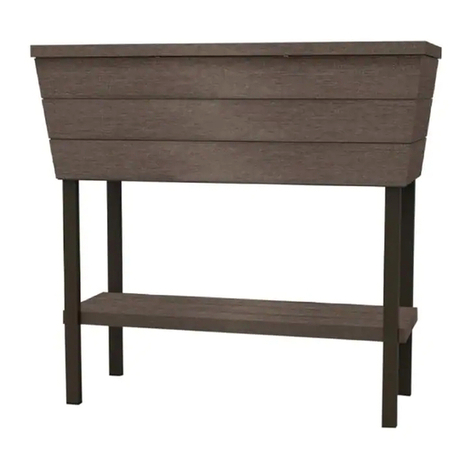
Keter
Keter Alfresco Garden Bed Assembly instructions

Westfalia
Westfalia 946960 manual
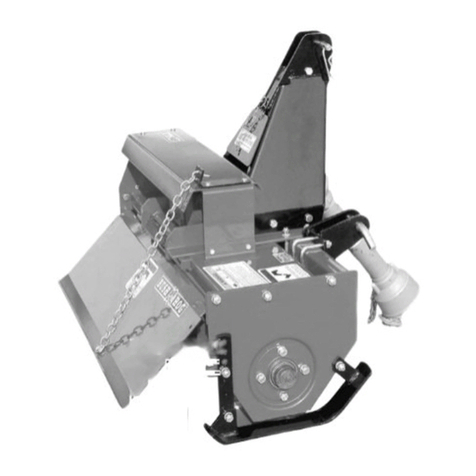
Bush Hog
Bush Hog RTS40 Operator's manual
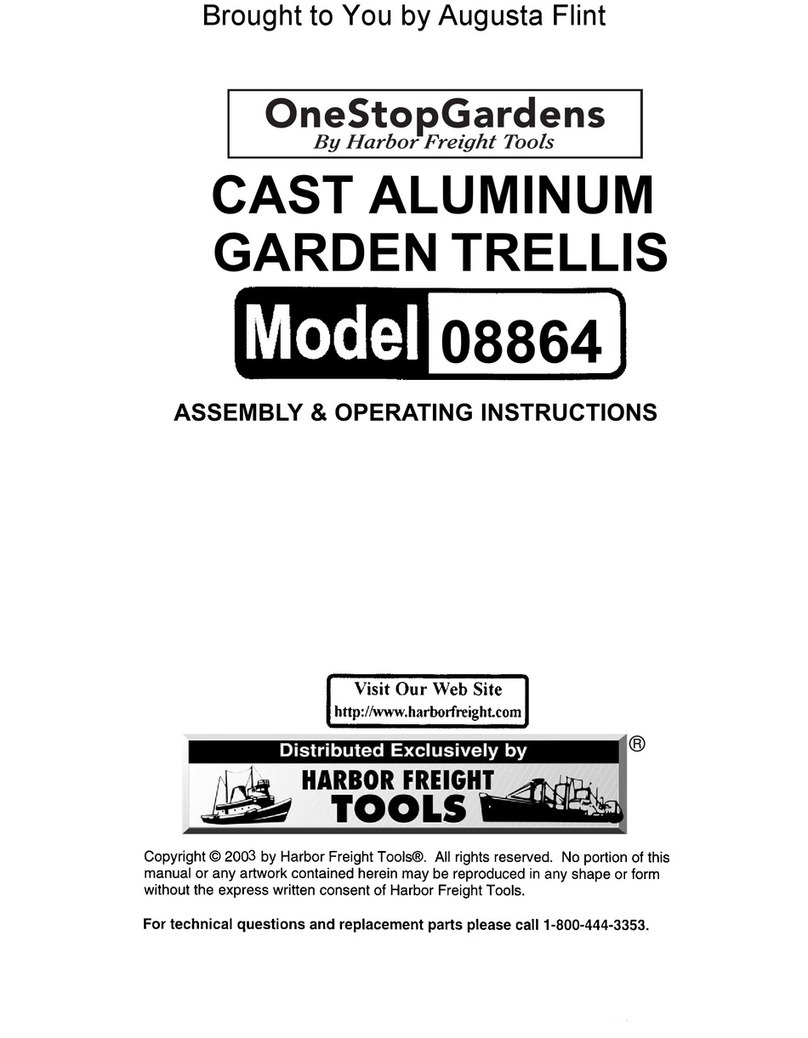
One Stop Gardens
One Stop Gardens 08864 Assembly & operating instructions
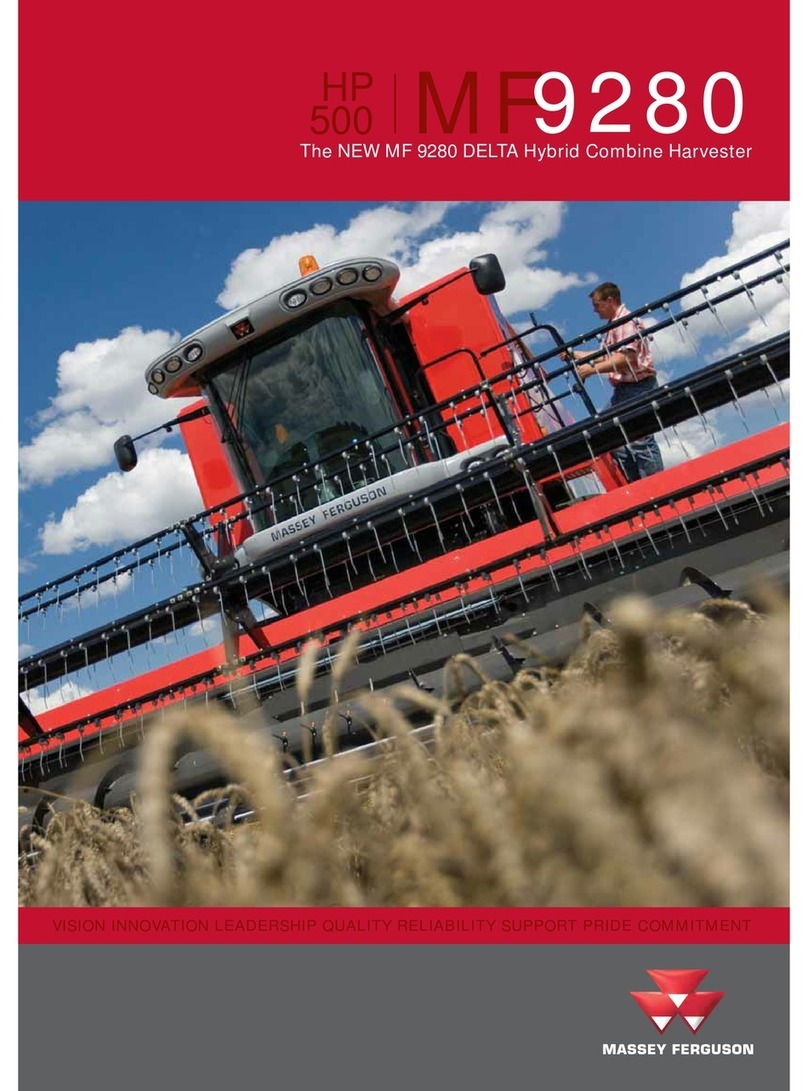
MASSEY FERGUSON
MASSEY FERGUSON MF9280 - HP 500 brochure
